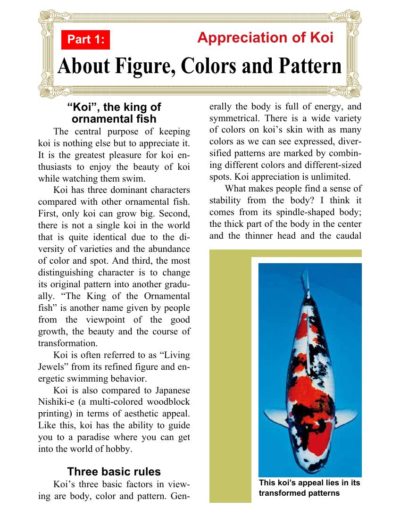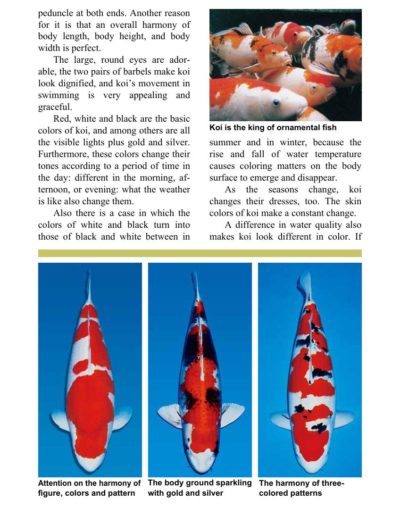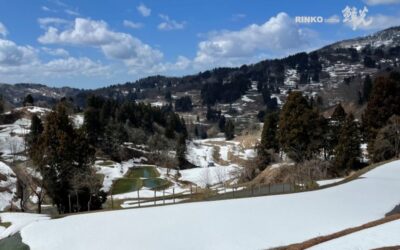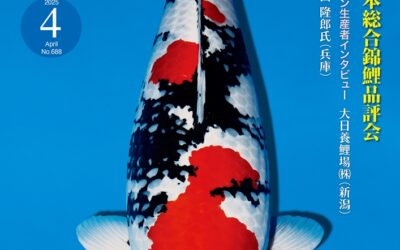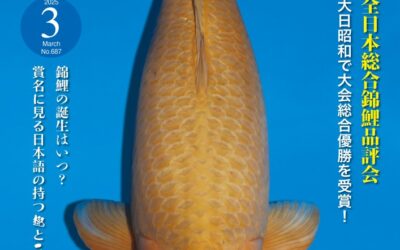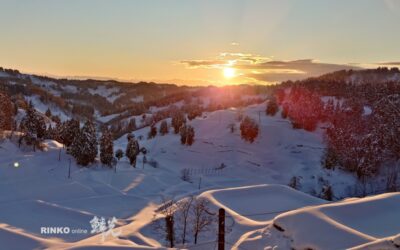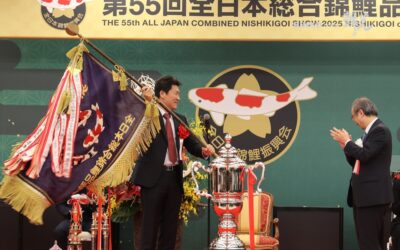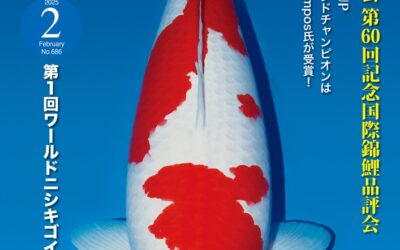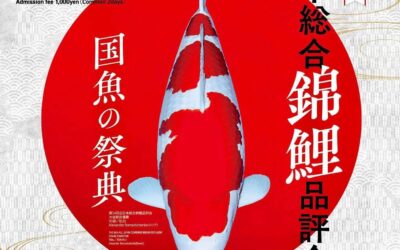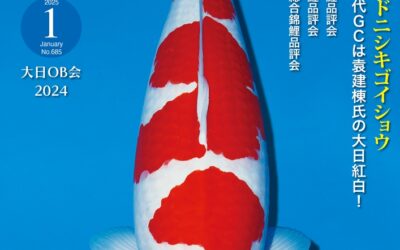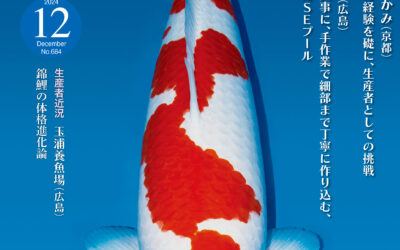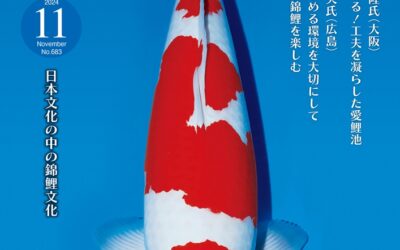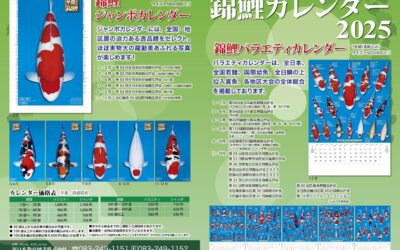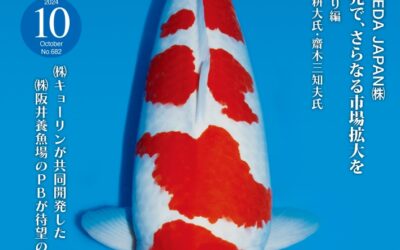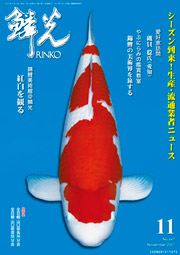Appreciation of Koi Part 1:
About Figure, Colors and Pattern
“Koi”, the king of ornamental fish
The central purpose of keeping koi is nothing else but to appreciate it. It is the greatest pleasure for koi enthusiasts to enjoy the beauty of koi while watching them swim.
Koi has three dominant characters compared with other ornamental fish. First, only koi can grow big. Second, there is not a single koi in the world that is quite identical due to the diversity of varieties and the abundance of color and spot. And third, the most distinguishing character is to change its original pattern into another gradually. “The King of the Ornamental fish” is another name given by people from the viewpoint of the good growth, the beauty and the course of transformation.
Koi is often referred to as “Living Jewels” from its refined figure and energetic swimming behavior.
Koi is also compared to Japanese Nishiki(a multilored woodblock printing) in terms of aesthetic appeal. Like this, koi has the ability to guide you to a paradise where you can get into the world of hobby.
Three basic rules
Koi’s three basic factors in viewing are body, color and pattern. Generally the body is full of energy, and symmetrical. There is a wide variety of colors on koi’s skin with as many colors as we can see expressed, diversified patterns are marked by combining different colors and differentzed spots. Koi appreciation is unlimited.
What makes people find a sense of stability from the body? I think it comes from its spindleaped body; the thick part of the body in the center and the thinner head and the caudal peduncle at both ends. Another reason for it is that an overall harmony of body length, body height, and body width is perfect.
The large, round eyes are adorable, the two pairs of barbels make koi look dignified, and koi’;s movement in swimming is very appealing and graceful.
Red, white and black are the basic colors of koi, and among others are all the visible lights plus gold and silver. Furthermore, these colors change their tones according to a period of time in the day: different in the morning, afternoon, or evening: what the weather is like also change them.
Also there is a case in which the colors of white and black turn into those of black and white between in summer and in winter, because the rise and fall of water temperature causes coloring matters on the body surface to emerge and disappear.
As the seasons change, koi changes their dresses, too. The skin colors of koi make a constant change.
A difference in water quality also makes koi look different in color. If koi is moved to one pond to another, its skin is naturally affected by water quality in the new pond. Soft water, in general, is said to make the skin finish softly, while hard water is most likely to help Sumi marks appear easily. Some experienced breeders who intend to enter for a show are devoting themselves to preparing living and shining pond water.
Koi originates in a mutation from Magoi, so there are some koi which drastically change their patterns more as they grow older. When it comes to “Jumbo” koi, it tends to build an image quite different from what it looked like in its youth. And there are too many examples of transformation to enumerate, such as “Jumbo” koi with the commonest looks turn to have gorgeous looks. Today koi has become an object of interest not only in Japan but also all over the world. Video footage shows their graceful swimming behavior. Koi seems to be hailed as “living jewels” by them.
This article is originally from the issue No.666 (2016 Nov)
Enjoy our collection of articles on Japanese koi news, updates, winners, educational articles, definitions and more!
Join as a free RINKO Member for increased access and subscribe as a paid member for full access to our content.
Magazine Issue Update
by RINKO online | Mar 27, 2025
[ Magazine Issue Update ] https://rinkoonline.com/magazine-issues/ ...
Japanese RINKO 2025 April issue adverts
by RINKO online | Mar 18, 2025
Japanese RINKO 2025 April issue adverts 鱗光2025年4月号掲載広告
Japanese RINKO 2025 March issue adverts
by RINKO online | Feb 20, 2025
Japanese RINKO 2025 March issue adverts 鱗光2025年3月号掲載広告
Magazine Issue Updates
by RINKO online | Feb 18, 2025
[ Magazine Issue Update ] https://rinkoonline.com/magazine-issues/ 1st World...
55th All Japan Koi Show Recap
by RINKO online | Jan 31, 2025
55th All Japan Koi Show RecapThe 55th All Japan Koi Show was held at Tokyo...
Japanese RINKO 2025 February issue adverts
by RINKO online | Jan 23, 2025
Japanese RINKO 2025 February issue adverts 鱗光 2025年2月号掲載広告 ...
55th All Japan Koi Show 2025
by RINKO online | Jan 18, 2025
The Biggest Event of the Year! The 55th Alll Japan Koi Show DATE: Jan 26-27th...
Japanese RINKO 2025 January issue adverts
by RINKO online | Dec 20, 2024
Japanese RINKO 2025 January issue adverts 鱗光 2025年1月号広告一覧 Front cover features...
Japanese RINKO 2024 December issue adverts
by RINKO online | Nov 21, 2024
Japanese RINKO 2024 December issue adverts 鱗光 2024年12月号掲載広告 ...
Japanese RINKO 2024 November issue adverts
by RINKO online | Oct 22, 2024
Japanese RINKO 2024 November issue adverts 鱗光 2024年11月号掲載広告
Nishikigoi Calendar 2025
by RINKO online | Sep 30, 2024
Nishikigoi Calendar 2025 *Jumbo Calendar [Jan/Feb] Grand Champion of the...
Japanese RINKO 2024 October issue adverts
by RINKO online | Sep 19, 2024
Japanese RINKO 2024 October issue adverts 鱗光 2024年10月号掲載広告
RINKO Koi Magazine is NOW available online!
Blog Categories
Reminder: You must login or register for website to vote in our polls.
Recent Posts
Upcoming Events
Author: RINKO Online
RINKO was published in 1962 as the first Nishikigoi magazine in the world. Dr Takeo Kuroki organized Oita Airinkai (koi club) with 53 members. He wrote the most articles which were written on A5 size paper, printed in black and white and 28 pages long with his wife’s artwork on the front cover. When Dr Kuroki met our founder Shuji Fujita, they consulted on publishing his first book “Nishikigoi”. This created hundreds and thousands of “koi-kichi” (koi lovers/people crazy about koi). Their work together resulted in the success of RINKO Issue 15, the first cover printed in color. Since then their journey of introducing Nishikigoi culture to the world has blossomed.

